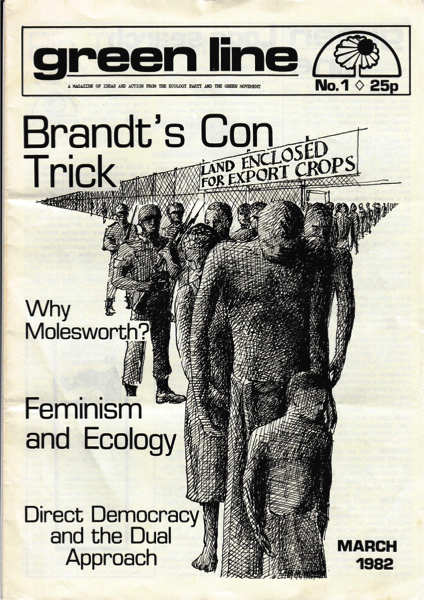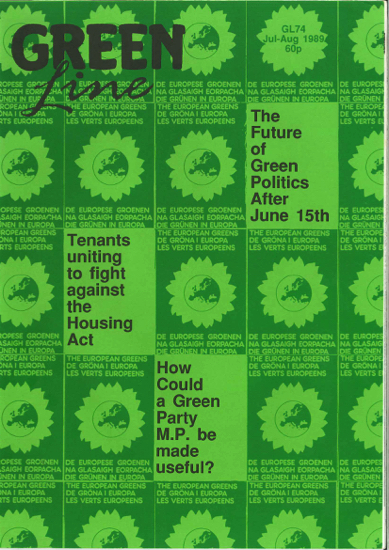
 The GreenLine Collective was responsible for producing and publishing the GreenLine newsletter from early 1982 through into the 1990's. It arose from a 1981 decision by Ecology Party Conference to stop the party producing a newsletter or magazine - the background and a history of the magazine is given in this article reprinted from the 100th issue (No.100 Sept'92) by Joanne Dean.
The GreenLine Collective was responsible for producing and publishing the GreenLine newsletter from early 1982 through into the 1990's. It arose from a 1981 decision by Ecology Party Conference to stop the party producing a newsletter or magazine - the background and a history of the magazine is given in this article reprinted from the 100th issue (No.100 Sept'92) by Joanne Dean.
You can get the original article here and also Jon Carpenter's 50th Issue look back here.
One hundred issues old
To mark GL's centenary issue, JOANNE DEAN, one of the editorial collective's more recent members, browses through the back issues to examine the magazine's history and its continuing evolution.
IN THE AUTUMN of 1981 problems with the Ecology Party's magazine, including the sacking of at least one editor, "because the party council didn't like his politics" (Jon Carpenter, GL 50), led to a motion being passed at the autumn conference which prohibited the party's national council from publishing a magazine for members. Inspired by the opportunity to fill the gap, several Eco members in Oxford set about producing "an independently edited and self-financing paper which would serve both the Eco party and the wider green movement with which it is allied". Six months later Green Line was launched The first issue was 12 pages long and included articles on the campaign against Rio Tinto Zinc, Feminism and Ecology, the new peace camp at Molesworth and a round up of Grassroots news from branches of the Ecology Party.
The early issues of the magazine maintained a close link with the Ecology Party and carried the subtitle "A Magazine of Ideas and Action from the Ecology Party and the Green Movement". News from the Ecology Party's branches was included along with speculation and suggestions for a new party logo. But by the fourth issue, the subtitle was changed to read "Magazine of the Green Movement", to broaden GL's appeal. While GL remained a magazine of ideas and action, it placed the Ecology Party firmly within the Green Movement and if it ever tended to focus too exclusively on electoral politics, there was always a reader ready to point this out. In 1984 the subtitle was removed completely after GL had been accused in a letter of being too political and of not reporting on a recent Green Gathering. Considering that earlier issues - had featured double page photo specials of such gatherings, a change could be perceived in the preoccupations of GL. In particular the magazine was increasingly concerned with political theory, in defining the Ecology Party's role and philosophy, and exploring its links with socialism and anarchy.
Down a green memory lane
Flicking through the 99 past issues of GL is a humbling experience. There is so much thought, debate, information, feeling and shared experiences; so many articles I want to read and so much to learn. I immersed myself in ten years of green thinking and discussion, as GL evolved, rolling forward the debates about green politics, revisiting knotty subjects time and again, each time to new readers, each time adding to, confirming or deveToping the material. I took myself back through the history of the last decade: GL's response to the Libyan bombing, to Chernobyl, the 1983, 1987 and 1992 general elections, peace camps, green gatherings, the publication of Seeing Green. The determination, energy and vision of hundreds of greens is all there. Years of action, thought and debate along with pages of inspiration and challenge, all feeding into the green movement of today.
Green Line's roots were in the peace and feminist movements as well as in ecological politics, and these issues were given a high profile in early editions, reflecting the interest and activity in them during the early 80's. Green Line has always been a reflective magazine. Its strength is that it refects a thoughtful, analytical and sensitive movement, which thrives on debate and challenge. Ten years of letters cover the whole panorama of green thinking, theory and action, as ideas are exchanged and wits sharpened. A recent readers' survey shows that the letters page is still a favourite part of the magazine, as is the comment section, where personal views are held out to the readership to start a debate or offer new perspectives.
As the green movement has grown, applying its green analysis to all aspects of our society, GL has evolved alongside. Its present claim to be a "Magazine of green politics and lifestyle", allows it to retain its diverse content and sets itself the task of combining political thinking and discussion with practical ways of being involved and living a green lifestyle.
Through the news sections the magazine is able to keep up to date with campaigns and maintain links with a range of pressure groups. Network was the first news section to develop in 1983, and from it grew International News in 1986 and Animal News the following year. Forest News is the most recent addition, starting in 1990 and reflecting a huge movement and interest on the issue of rainforest destruction. The news sections act as a resource base, networking campaigns; as one reader claims, GL "facilitates co-operation without meetings".
Green Line's personal history is also contained in the pages of the mags. The collective has steadily changed over the decade, as new people added their own particular interests and skills, and I was intrigued to read of some of the people who had been involved: where are they now? GL prospered and branched out into publishing pamphlets and leaflets. It abandoned its typing and letraset and became computerised and, finally, desktop published. The early issues of GL contain stunning illustrations by Andy Kaye, bold pictures and empowering images, which speak of the optimism of that time. But such optimism was seen as incompatible with credibility by one reader in 1986 (GL45), who accused the magazine of being "an eye-sore". He expressed "utter contempt for the visual appearance of it", and urged GL to look more "competent and professional". GL has resisted any calls for it to go glossy, and is supported in this by comments in the Readers' Survey. In its production it has tried to remain green, for instance using unbleached "grey" paper for the past year. I know we should be hand-making the paper from hemp, but that will have to wait until we have more volunteers.
Voluntary work
GL has always relied on the willingness and availability of its volunteers. It is ironic that at the height of the popularity of the Green Party and the rise of environmental awareness, GL stopped production from Autumn 1989 to March 1990. Members of the collective were exhausted, being involved in other activities besides publishing. There was also the strain of trying to keep up with all things green: "The process of getting the mag out through voluntary effort is becoming increasingly difficult - especially with the overwhelming amount of new ideas, media coverage etc. on the green movement that GL ought to be analysing and commenting on". This editorial in GL75 recognised, though, that the media was making a "pig's ear of reporting the changes that are going on" and GL recovered to start again, taking its place amid a growing number of green magazines. A more recent financial crisis has been weathered successfully, and the magazine continues to come out ten times a year.
GL is still produced in Oxford from a collective member's spare room, though plans are afoot to move into a small office before long. The struggle to keep publishing, let alone deal with correspondence and commission articles, continues to occupy the collective, which is set for more changes of personnel in the near future. It is hard to predict how GL will evolve over the next hundred issues, but as with the previous hundred, the interests and enthusiasms of its readers will play an important role in shaping the magazine's future.
The entire GreenLine archive of issues from 1982 through to 1989 is in the process of being scanned and made available. They will probably appear in batches of a year (ten issues) at a time. An index of articles will be provided and the scanned originals available for download in the document library.
On a personal note I would echo Joanne's comments when she re-read the first 100 issues back in 1992, even today in 2017 they remain as relevant, fascinating, informative and often prescient as ever. Lots of stuff in there worth reviewing - check out the Contents and if you are inspired to write an article reflecting from today one one of the themes that preoccupied the green movement in the 70's and 80's then join us and make a proposal.
